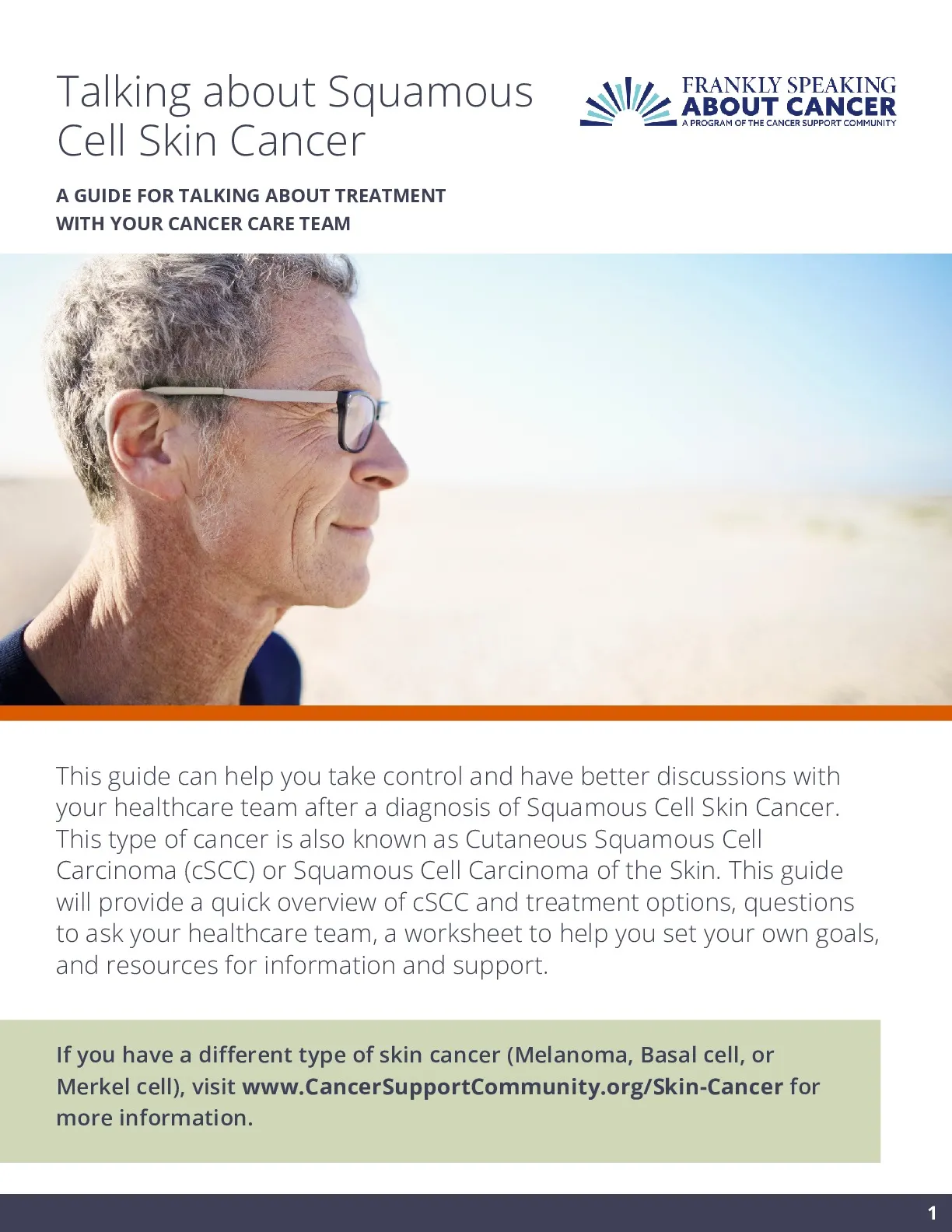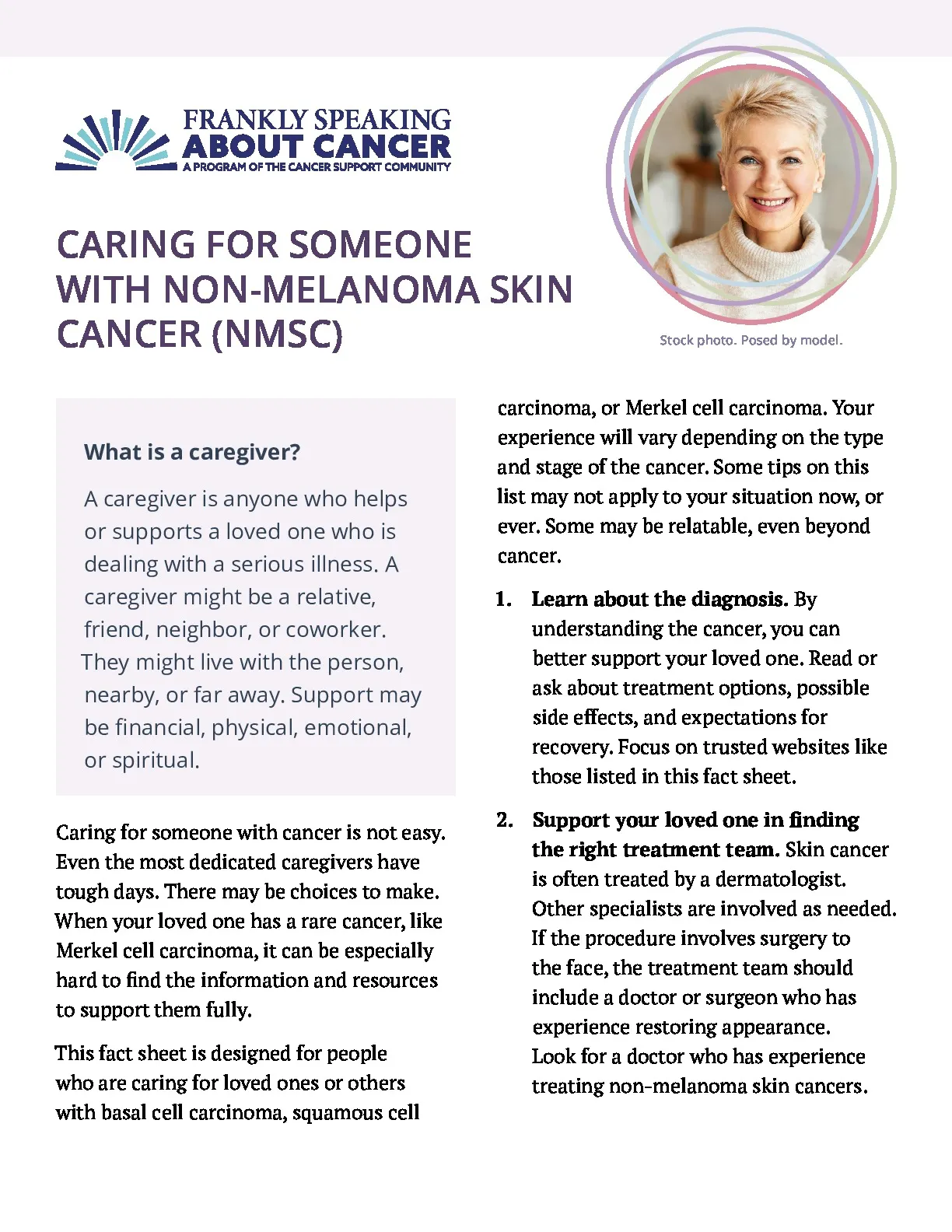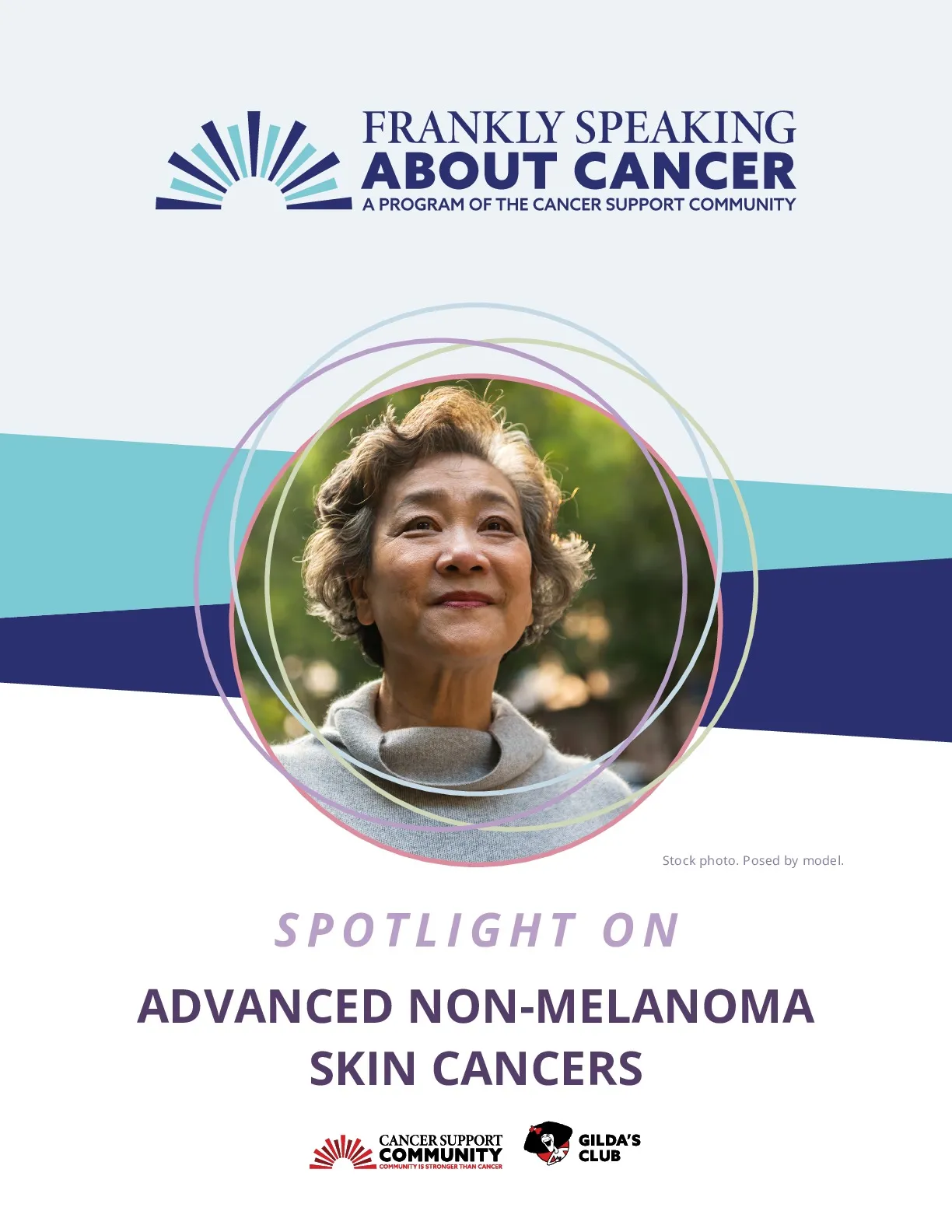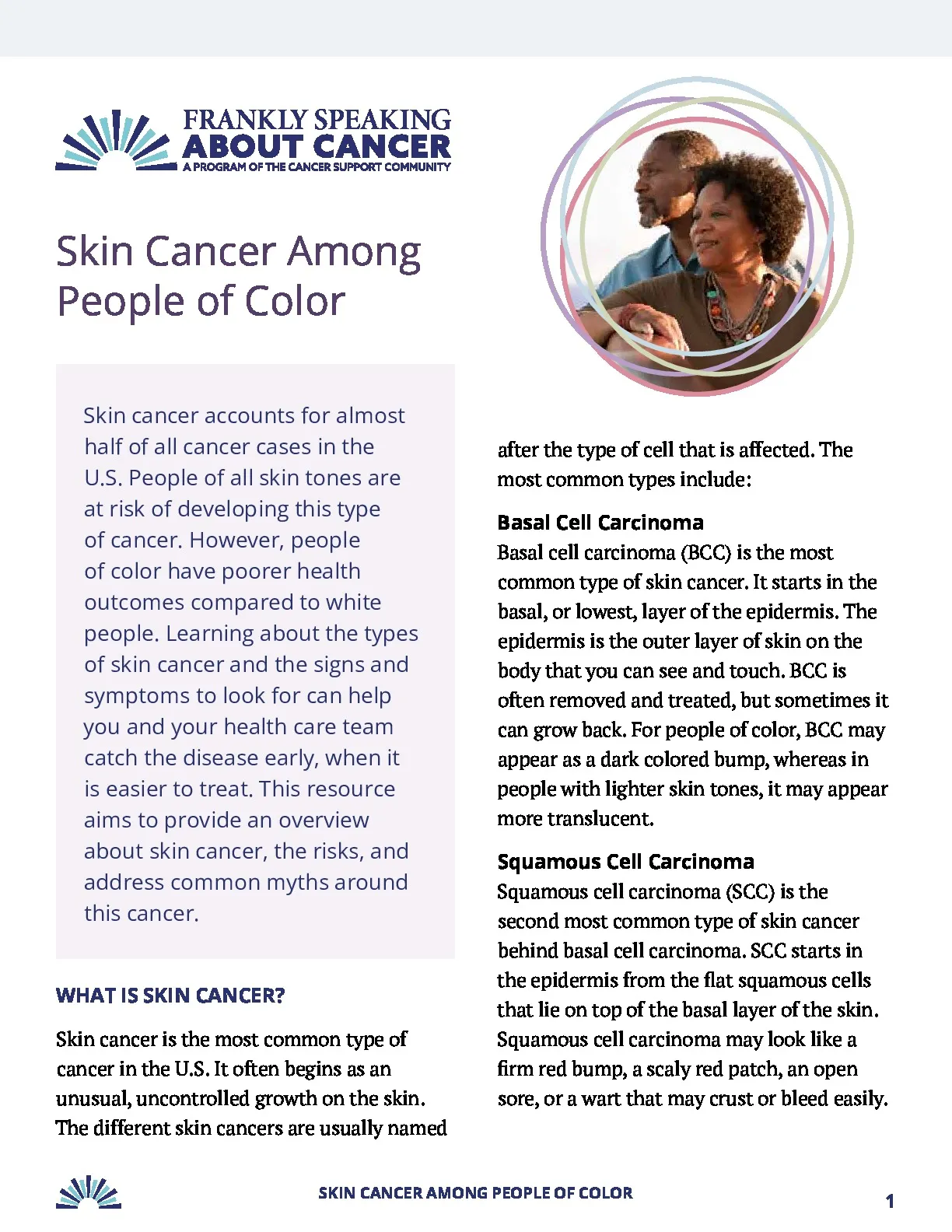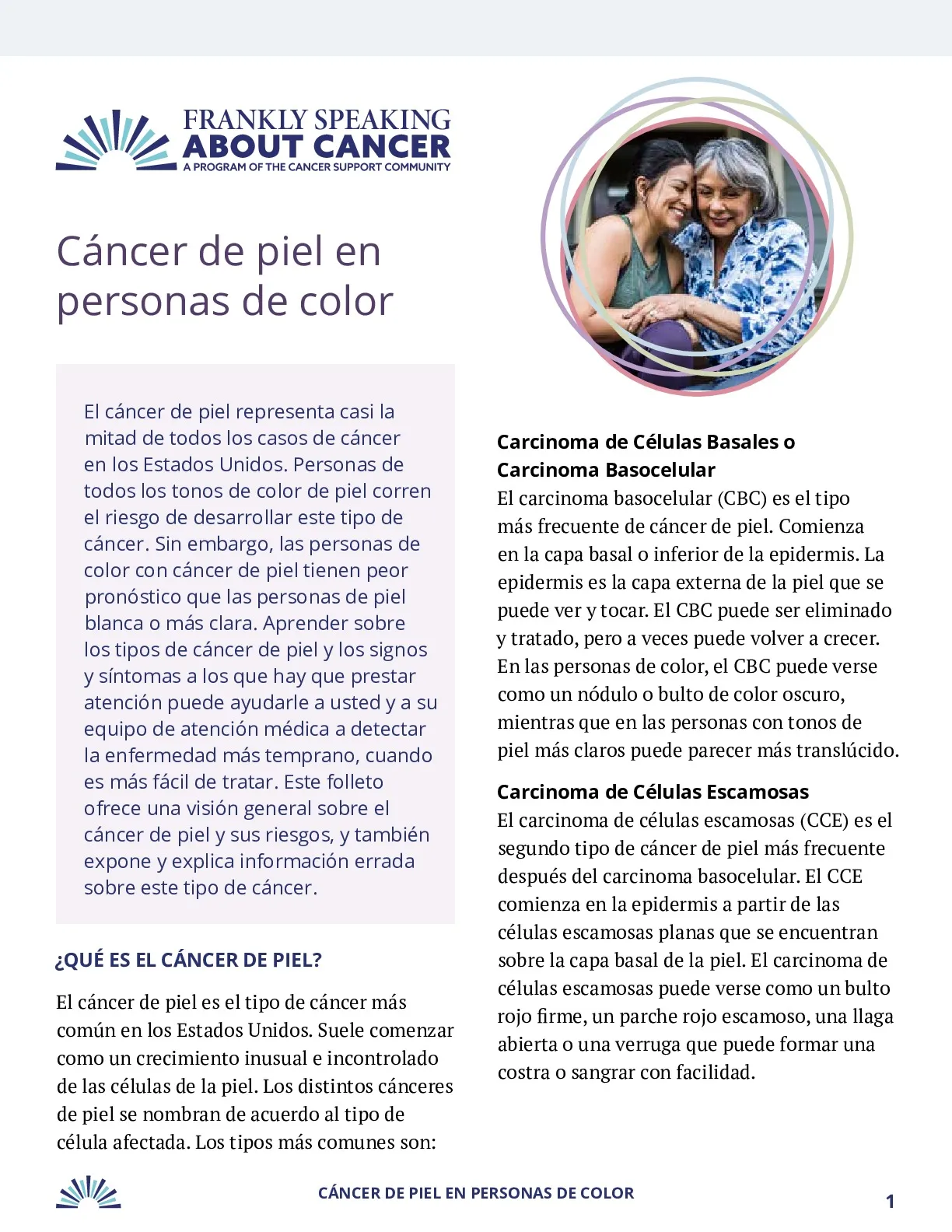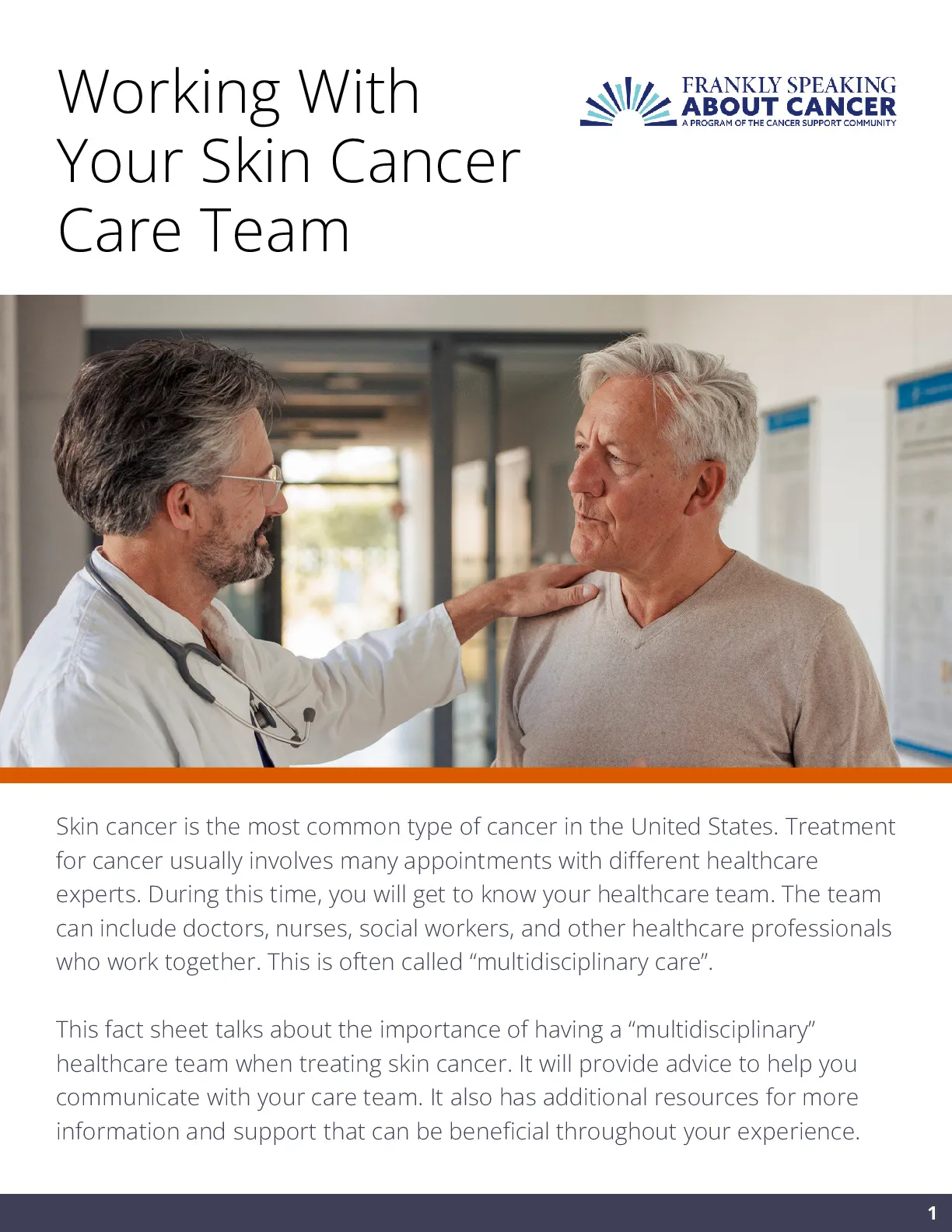Squamous Cell Carcinoma of the Skin
Table of Contents
This type of cancer is also known as Cutaneous Squamous Cell Carcinoma (cSCC). After Basal Cell Carcinoma, cSCC is the second most common type of skin cancer. It starts in the epidermis from the flat squamous cells that lie on top of the basal layer of the skin. The epidermis is the outer layer of skin on the body that you can see and touch. This cancer usually shows up on sun-exposed areas of the body, like the face, ears, and neck. But it can occur in other areas too. This cancer is usually found early and treated by being removed completely. Sometimes cSCC can grow back, and in rare cases, spread to other parts of the body.

New: Talking About Squamous Cell Skin Cancer
Take control and have better discussions with your healthcare team after a diagnosis.
Quick Guide to Advanced Non-Melanoma Skin Cancers
Watch this Quick Guide to Advanced Non-Melanoma Skin Cancer to find out more about the types of non-melanoma skin cancer, diagnosis, staging, treatment, and treatment side effects.
Risk Factors
Known risk factors for squamous cell skin cancer include:
- Exposure to sunlight or ultraviolet radiation from tanning booths
- Frequent blistering sunburns, especially early in life
- Having a fair complexion, which includes the following:
- Fair skin that freckles and burns easily, does not tan, or tans poorly
- Blue, green, or other light-colored eyes
- Red or blond hair
- A personal history of skin cancer
- Having more than 50 moles
- Possible genetic factors (mutations in certain genes or a family history)
- History of radiation therapy, certain conditions that suppress the immune system, or exposure to high levels of arsenic
- Solid organ transplant recipients are at a very high risk of developing cSCC after transplantation. This is due to the immunosuppressive medication used. Immunosuppressive medication is a drug that suppresses the immune response of an individual.
Signs & Symptoms
As always, talk with your health care provider if you notice anything unusual on your skin, or if you have a sore or patch of skin that will not heal. Tell your doctor if you notice changes or anything unusual on your skin. Do monthly skin checks — check all the surfaces of your skin and look closely at your moles so that you can tell if they begin to change in shape, size, or color. Cutaneous squamous cell carcinoma may look like a firm red bump, a scaly red patch, an open sore, or a wart that may crust or bleed easily.
Screening, Diagnosis
Tests that are commonly used to find skin cancer include:
- Skin exams – A dermatologist will check the skin for bumps, moles, or spots that look abnormal in color, size, shape, or texture.
- Skin biopsy – If needed, all or part of an abnormal-looking growth is cut from the skin. A pathologist will look at the sample under a microscope to check for signs of cancer. Different types of biopsies may be used depending on cancer and its location.
- Shave biopsy: A doctor uses a sterile blade to shave off a growth that looks abnormal.
- Punch biopsy: A special instrument is used to cut out circular pieces of skin or tissue.
- Incisional biopsy: The doctor removes part of a growth using a scalpel.
- Excisional biopsy: The doctor removes the entire growth or abnormal area of skin using a scalpel.
If the disease is more advanced, other diagnostic tests may be added, including CT or PET scans. However, this is done very infrequently.
How is cSCC found?
Your doctor will examine your skin. He or she may remove the growth or part of it. This is called a skin biopsy. A biopsy is needed to confirm a diagnosis.
To get a sample of the skin/suspicious spot, the area will be numbed with a medication injected into the skin. Then the doctor (often a dermatologist or skin doctor) will cut the skin to get a sample of tissue. A different doctor (called a pathologist or dermatopathologist) will look at this tissue under the microscope to check for cancer cells. There are several types of biopsies.
Ask your doctor when he/she will review the results with you.
Can it spread beyond the skin?
Squamous cell carcinoma usually grows slowly and is contained to the outer layer of the skin. In some cases, especially if it is untreated, it can invade nearby tissue.
If multiple surgeries are needed, it can be disfiguring and may affect function. For example, if squamous cell carcinoma grows deeply on the lower lip, surgeries to remove it may cause cosmetic issues, and also interfere with someone’s ability to smile or close their mouth.
Although rare, it is possible for squamous cell carcinoma to spread (metastasize) to other parts of the body.
Questions to Ask Your Doctor
- What type of biopsy will be done?
- How soon will I know the results?
- What stage is my cancer?
- What treatment is most likely to work?
- Are there side effects I need to be aware of?
- How likely is it that it will return?
- What should I be doing to help protect myself in the future?
- Do you have experience treating this type of cancer, or know someone who does?
Staging
Squamous cell skin cancer is often broken into the following categories:
Local: Tumors that are confined to the original site of disease. Local cSCC is usually curable.
Locally advanced: Tumors that have spread to surrounding skin or lymph nodes. Locally advanced cSCC can be curable by surgery or radiation.
Unresectable: Tumors that can no longer be cured by surgery and/or radiation. Unresectable cSCC cannot be cured but can be controlled by treatments like chemotherapy and immunotherapy.
Metastatic: Tumors that have spread beyond the original area to other parts of the body. Metastatic cSCC cannot be cured but can be controlled by treatments like chemotherapy and immunotherapy.
Local Versus Advanced cSCC
Your doctor may also use the words “local” and “advanced” to describe your cSCC. Local cSCC is treated very differently than the other categories. Most people who have cSCC have local disease. When you read about cSCC being highly curable, that is for the 95% of people who have local cSCC.
Treatments and Side Effects
Treatment for cSCC depends on your cancer stage, the size and location of the tumor, your treatment preferences, and overall health.
Treatment options for cSCC may include:
- Surgery
- Topical Medications
- Cryotherapy
- Radiation Therapy
- Chemotherapy
- Immunotherapy
- Targeted therapy
- Clinical Trials
Surgery is used to remove cancer cells. Different surgical techniques may be recommended.
- Excision – The entire tumor is surgically removed along with a surrounding border of healthy tissue.
- Curettage and electrodesiccation (C and E) – the tumor is scraped down to its base followed by pulses of electrical energy. This helps prevent bleeding at the site.
- Mohs surgery – The goal is to remove skincancer one layer at a timeuntil normal, healthy tissue is reached. After each layer is removed, it is sent to an on-site laboratory to be examined by the surgeon. This allows your dermatologic surgeon to know whether more layers need to be removed in real-time.
- Cryosurgery – Liquid nitrogen is applied to the tumor to freeze and destroy it.
Possible side effects of surgery may include pain, scarring, numbness, skin stretching, wound problems, infection, and changes in appearance where the surgery was performed.
You may work with a palliative care specialist to address any side effects. Palliative care focuses on improving quality of life and helping to reduce pain and other symptoms. Seeing a palliative care specialist can help address many side effects that may arise during treatment. Palliative care is different from hospice care and end-of-life care. It is available to you at any point of your treatment experience.
Topical medications are applied to the skin when skin cancer is a type that is known to be very thin. Treatments may include photodynamic therapy (a light-sensitive drug is applied to the skin cancer cells), cryotherapy (a cold liquid is used to freeze the cancer cells), and topical drugs (5-fluorouracil also known as 5-FU).
Possible side effects for topical medications include pain, itching, burning, irritation, inflammation, dryness, swelling, and tenderness at the site of application.
Cryotherapy is a procedure in which an extremely cold liquid is used to freeze and kill abnormal cells. The cold liquid is called liquid nitrogen, liquid nitrous oxide, or compressed argon gas.
Radiation therapy is the use of high-energy rays to kill or damage cancer cells. It is given before, during, or after other treatments. The goal is to damage as many cancer cells as possible without harming healthy tissue. To lessen the damage, doses are given in very precisely mapped areas.
Common side effects include nausea, fatigue, and skin changes like redness, dryness, or itching at the site of treatment. Other side effects are specific to the part of the body being treated. Side effects can last after treatment is done.
Radiation is most often used in patients who cannot undergo surgery or it sometimes may be used after a patient has had surgery. It may also be used in patients who have cSCC that has spread to lymph nodes.
Chemotherapy involves the use of drugs to destroy cancer cells. It is a systemic (whole-body) treatment. This means it can destroy cancer cells almost anywhere in your body. It may be given by IV (through a vein), in pill form (by mouth), as an injection (a shot), applied directly on the skin into the area around the tumor, or placed directly into the tumor site. Most often, chemo is given in an outpatient clinic. You will have a regular schedule of treatments for a set period of time.
Chemotherapy is most effective against fast-growing cells, like cancer. But some healthy, normal cells may also be damaged by this treatment. The side effects will vary depending on the drug(s) you take, the dose of your drugs, and how often you get treatments. Common side effects include mouth sores, fatigue, hair loss, nausea, “chemo brain,” and low blood cell or platelet counts. Chemotherapy may not be appropriate for all patients.
Immunotherapy uses the body’s natural defenses (the immune system) to find, attack, and kill cancer cells. The immune system’s job is to attack any cell that it sees as unhealthy or abnormal. Cancer cells can hide from these defenses or even stop an attack. Most immunotherapy is given by IV (through a vein). You may get treatment in a doctor’s office, in a clinic, or as an outpatient. It is important to review that immunotherapies may not be a good option for those on immunosuppressive medications.
Targeted therapy aims to more precisely attack cancer cells. These drugs target changes in the genes or proteins of cancer cells that help them grow, divide, and spread. They treat the cancer cells with less harm to normal cells. There are different types of targeted therapy. Targeted therapy is being studied for this type of cancer. Currently available targeted therapy cSCC may be given as an IV (through a vein). Ask if it is an option for you.
Common side effects include skin problems (rash, dry skin, itching), fatigue, or a flu-like reaction with fever, chills, and diarrhea.
Be sure to ask about clinical trials. Clinical trials are research studies to test new treatments or learn how to use current treatments better. Today’s standard drugs were once in clinical trials. Tomorrow’s drugs are in them today.
In some cases, the treatments with the best chance of success may be available only through clinical trials. Trials are offered for many cancers, at many different stages. Everyone is not eligible for every trial. If you have cancer that has come back or spread, it is especially important to ask about clinical trials.
Follow-up Care
Because skin cancer can come back, be sure to ask your doctor how often to have your skin checked for signs of cancer. Remember to keep any follow-up visits.
As a cancer survivor, I accept the journey of recurring squamous cell carcinoma. Having a good mental attitude, eating well, and being secure in my faith help keep my focus on the positive.

Coping
Get Tips to Manage Side Effects
Receiving a cancer diagnosis and undergoing cancer treatment can be challenging for both you and your loved ones. Unwanted side effects can intensify the disruption in your life even further. Your body, cancer diagnosis, and cancer treatment are unique. Talk to your doctor about what side effects are likely to occur and about ways to manage and treat them.
Get Tips to Manage Stress From Cancer
Stress and anxiety go hand-in-hand with a cancer diagnosis. Moreover, just because your active treatment has ended, it doesn’t mean the stress and anxiety will as well. You may worry about whether the treatment worked. Or your cancer treatments may have brought changes to your body that you need to adapt to.
Get Tips to Manage Cancer Treatment Costs
Asking for and accepting help can be hard. Many families facing cancer have shared with the Cancer Support Community that financial worries about cancer costs are a significant source of stress, and they don't know where to turn.
Frankly Speaking About Cancer Library
LibraryWould you like a print copy of these educational materials?
We can mail our Frankly Speaking About Cancer pieces to you. Shipping is free for up to 20 pounds.
